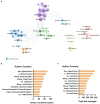Exploring research hotspots and future directions in neural tube defects field by bibliometric and bioinformatics analysis
- PMID: 38650623
- PMCID: PMC11033379
- DOI: 10.3389/fnins.2024.1293400
Exploring research hotspots and future directions in neural tube defects field by bibliometric and bioinformatics analysis
Abstract
Background: Neural tube defects (NTDs) is the most common birth defect of the central nervous system (CNS) which causes the death of almost 88,000 people every year around the world. Much efforts have been made to investigate the reasons that contribute to NTD and explore new ways to for prevention. We trawl the past decade (2013-2022) published records in order to get a worldwide view about NTDs research field.
Methods: 7,437 records about NTDs were retrieved from the Web of Science (WOS) database. Tools such as shell scripts, VOSviewer, SCImago Graphica, CiteSpace and PubTator were used for data analysis and visualization.
Results: Over the past decade, the number of publications has maintained an upward trend, except for 2022. The United States is the country with the highest number of publications and also with the closest collaboration with other countries. Baylor College of Medicine has the closest collaboration with other institutions worldwide and also was the most prolific institution. In the field of NTDs, research focuses on molecular mechanisms such as genes and signaling pathways related to folate metabolism, neurogenic diseases caused by neural tube closure disorders such as myelomeningocele and spina bifida, and prevention and treatment such as folate supplementation and surgical procedures. Most NTDs related genes are related to development, cell projection parts, and molecular binding. These genes are mainly concentrated in cancer, Wnt, MAPK, PI3K-Akt and other signaling pathways. The distribution of NTDs related SNPs on chromosomes 1, 3, 5, 11, 14, and 17 are relatively concentrated, which may be associated with high-risk of NTDs.
Conclusion: Bibliometric analysis of the literature on NTDs field provided the current status, hotspots and future directions to some extant. Further bioinformatics analysis expanded our understanding of NTDs-related genes function and revealed some important SNP clusters and loci. This study provided some guidance for further studies. More extensive cooperation and further research are needed to overcome the ongoing challenge in pathogenesis, prevention and treatment of NTDs.
Keywords: bibliometric; bioinformatics; gene; neural tube defects (NTDs); single nucleotide polymorphism (SNP).
Copyright © 2024 Cao, Su, Li, Ao, Xu, Liang, Liu, Yu and Xie.
Conflict of interest statement
The authors declare that the research was conducted in the absence of any commercial or financial relationships that could be construed as a potential conflict of interest.
Figures









Similar articles
-
Exploring Research Trends and Mechanisms: Maternal Diabetes and Neural Tube Defects (1991-2023).J Multidiscip Healthc. 2025 Feb 25;18:1107-1121. doi: 10.2147/JMDH.S501402. eCollection 2025. J Multidiscip Healthc. 2025. PMID: 40026865 Free PMC article.
-
Spina bifida and other neural tube defects.Curr Probl Pediatr. 2000 Nov-Dec;30(10):313-32. doi: 10.1067/mpp.2000.112052. Curr Probl Pediatr. 2000. PMID: 11147289 Review.
-
Reducing inequities in preventable neural tube defects: the critical and underutilized role of neurosurgical advocacy for folate fortification.Neurosurg Focus. 2018 Oct;45(4):E20. doi: 10.3171/2018.7.FOCUS18231. Neurosurg Focus. 2018. PMID: 30269587 Free PMC article.
-
High levels of iron supplementation prevents neural tube defects in the Fpn1ffe mouse model.Birth Defects Res. 2017 Jan 30;109(2):81-91. doi: 10.1002/bdra.23542. Birth Defects Res. 2017. PMID: 28008752 Free PMC article.
-
Mouse mutants with neural tube closure defects and their role in understanding human neural tube defects.Birth Defects Res A Clin Mol Teratol. 2007 Mar;79(3):187-210. doi: 10.1002/bdra.20333. Birth Defects Res A Clin Mol Teratol. 2007. PMID: 17177317 Review.
Cited by
-
Genes related to neural tube defects and glioblastoma.Sci Rep. 2025 Jan 30;15(1):3777. doi: 10.1038/s41598-025-86891-2. Sci Rep. 2025. PMID: 39885289 Free PMC article.
-
Activation of lipophagy ameliorates cadmium-induced neural tube defects via reducing low density lipoprotein cholesterol levels in mouse placentas.Cell Biol Toxicol. 2024 May 21;40(1):35. doi: 10.1007/s10565-024-09885-2. Cell Biol Toxicol. 2024. PMID: 38771546 Free PMC article.
References
LinkOut - more resources
Full Text Sources
Miscellaneous

